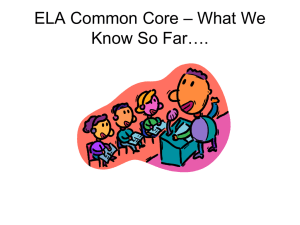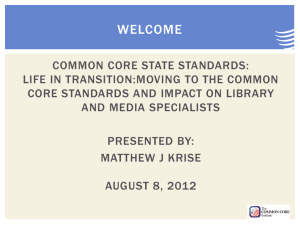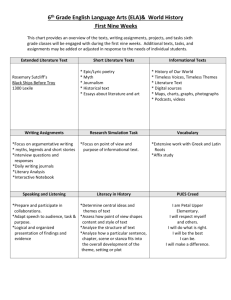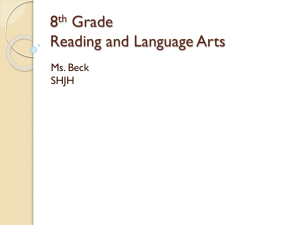An Introduction to the PA Common Core
advertisement
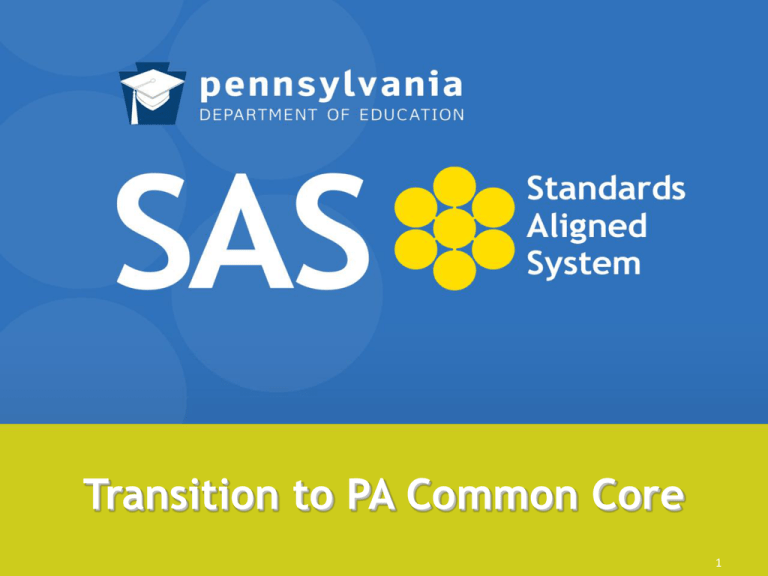
Transition to PA Common Core 1 Status Check What best describes your knowledge of the PA Common Core Standards? • • • • Aware (I know they’re out there.) Informed (I’ve read, attended PD, explored on-line, etc.) Ready (I’m using them.) Expert (I could help others understand and implement.) 2 Status Check Where is you local district in PA Common Core curriculum development? A. B. C. D. Aligned to PA Common Core State Standards Have not touched curriculum in 5 years Textbook is your curriculum Waiting for further information 3 PA Common Core Introduction Essential Questions • How do the PA Common Core Standards differ from the existing Pennsylvania Standards? • What is rigor in the classroom? How does this relate to Webb’s Depth of Knowledge? • What are the instructional implications of the shift to the PA Common Core Standards? 4 An Introduction to the PA Common Core Why Common Core? • Disparate standards across states • Global competition • Today’s jobs require different skills • States are ready and able for collective action • Aligned with college and work expectations 5 An Introduction to the PA Common Core Why Common Core? http://www.youtube.com/watch?v=dY2mRM4i6tY 6 Common Core Readiness Profile • • • • • • • Collaboration Application Communication Analysis Adaptation Evaluation Critical Thinking 7 Webb’s Depth of Knowledge 8 Webb’s DOK • A scale of cognitive demand (thinking) to align standards with assessments • Based on the research of Norman Webb, University of Wisconsin Center for Education Research and the National Institute for Science Education • Guides item development for state assessments 9 Webb’s DOK Levels of Complexity Level 1: Student recalls facts, information, procedures, or Recall & definitions. Reproduction Level 2: Skills & Concepts Level 3: Student uses information, conceptual knowledge, and procedures. Student uses reasoning and develops a plan or sequence Strategic Thinking of steps; process has some complexity. Level 4: Student conducts an investigation, needs time to think and Extended Thinking process multiple conditions of problem or task. 10 Webb’s DOK The Depth of Knowledge is NOT determined by the verb, but the context in which the verb is used and the depth of thinking required. DOK 3- Describe a model that you might use to represent the relationships that exist within the rock cycle. (requires deep understanding of rock cycle and a determination of how best to represent it) DOK 2- Describe the difference between metamorphic and igneous rocks. (requires cognitive processing to determine the differences in the two rock types) DOK 1- Describe three characteristics of metamorphic rocks. (simple recall) 11 Webb’s DOK How many of you know the definition of exaggerate? If all of you know the definition, this question is an easy question. (DOK 1 - Recall ) How many of you know the definition of prescient? If most of you do not know the definition, this question is a difficult question. (DOK 1 – Recall) 12 What is RIGOR? Rigor is… • more than what you teach and the standards you cover • how you teach and how students show you they understand • creating an environment in which each student is expected to learn at high levels • supporting each student so he or she can learn at high levels and demonstrates learning at high levels. (Blackburn, 2008) 13 English Language Arts 14 Essential Questions • How are the PA Common Core ELA standards structured? • How does ELA instruction look when it is aligned to PA Common Core standards? • What changes are needed in the current curriculum to meet the level of expectations required by PA Common Core Standards? 15 An Introduction to the PA Common Core ELA Standards PA Common Core Standards English Language Arts & Literacy College and Career Readiness Anchor Standards 1.1 Foundational Skills A necessary component of an effective, comprehensive reading program designed to develop proficient readers. sive 1.2 Reading Informational Text Enables students to read, understand, and respond to informational texts. 1.3 Reading Literature Enables students to read, understand, and respond to literature. 1.4 Writing Develops the skills of informational, argumentative, and narrative writing as well as the ability to engage in evidence based analysis of text and research. 1.5 Speaking & Listening Focuses students on communication skills that enable critical listening and effective presentation of ideas. 16 PA Standard English Language Arts CC. 1. 2. 3. A PA Common Core English Language Arts Grade Level Reading Informational Skills Standard 1 Standard Categories: 1 Foundation Skills 2 Reading Informational Skills 3 Reading Literature 4 Writing 5 Speaking and Listening 17 PA Assessment Anchors and Eligible Content English Language Arts E. 03. B-K. 1. 1. 2 Grade Assessment Anchor Anchor Descriptor Eligible Content Reporting Categories A = Literature Text B = Informational Text A-K and B-K = Key Ideas and Details A-C and B-C = Craft and Structure/Integration of Knowledge and Ideas A-V and B-V = Vocabulary Acquisition and Use C = Writing D = Language 18 STANDARD CATEGORY 1.2 Reading Informational Text Students read, understand and respond to informational text-with emphasis on comprehension, making connections among ideas and between texts with focus on textual evidence. GRADE LEVEL STANDARD CC.1.2.3.A Determine the main idea of a text; recount the key details and explain how they support the main idea. ASSESSMENT ANCHOR-The Assessment Anchors represent categories of subject matter (skills and concepts) that anchor the content of the PSSA. Each Assessment Anchor is part of a Reporting Category and has one or more Anchor Descriptors unified under and aligned to it. E03.B-K.1 Key Ideas and Details ANCHOR DESCRIPTOR-The Anchor Descriptor adds a level of specificity to the content covered by the Assessment Anchor. Each Anchor Descriptor is part of an Assessment Anchor and has one or more Eligible Content unified under and aligned to it. E03.B-K.1.1 Key Ideas and Details Demonstrate the understanding of key ideas and details in informational texts. ELIGIBLE CONTENT-The Eligible Content is the most specific description of the skills and concepts assessed on the PSSA. This level is considered the assessment limit and helps educators identify the range of the content covered on the PSSA. E03.B-K.1.1.2 Determine the main idea of a text; recount the key details and explain how they support the main idea. 19 STANDARD CATEGORY 1.3.L: Reading, Analyzing, and Interpreting Literature – Fiction and Non-Fiction GRADE LEVEL STANDARD 1.3.9-10.A Describe and compare the differing characteristics that distinguish the fiction and non-fiction forms of narrative, poetry, drama, and essay and determine how the form relates to meaning… ASSESSMENT ANCHOR-The Assessment Anchors represent categories of subject matter (skills and concepts) that anchor the content of the Keystone Exam. Each Assessment Anchor is part of a Reporting Category and has one or more Anchor Descriptors unified under and aligned to it. L.F.2 Analyzing and Interpreting Literature – Fiction ANCHOR DESCRIPTOR-The Anchor Descriptor adds a level of specificity to the content covered by the Assessment Anchor. Each Anchor Descriptor is part of an Assessment Anchor and has one or more Eligible Content unified under and aligned to it. L.F.2.1 Use appropriate strategies to make and support interpretations of literature. ELIGIBLE CONTENT-The Eligible Content is the most specific description of the skills and concepts assessed on the Keystone Exam. This level is considered the assessment limit and helps educators identify the range of the content covered on the Keystone Exam. L.F.2.1.2 Cite evidence from a text to support generalizations. 20 Webb’s DOK Activity: What is the DOK? Levels of Complexity Level 1: Student recalls facts, information, procedures, or Recall & definitions. Reproduction Level 2: Student uses information, conceptual knowledge, and Skills & Concepts procedures. Level 3: Student uses reasoning and develops a plan or Strategic Thinking sequence of steps; process has some complexity. Level 4: Student conducts an investigation, needs time to think Extended Thinking and process multiple conditions of problem or task. 21 Literacy Priorities Among the highest priorities of the Common Core State Standards is that students must read texts closely and acquire knowledge. At each grade level, 80 to 90 percent of the reading standards require text-dependent analysis. Questions that expect student responses to be textdependent and discipline-specific require students to demonstrate that they understand the text details and can provide accurate evidence. 22 Balancing Literary and Informational Texts Grade Grade 4 Grade 8 Grade 12 Text Emphasis Literary Informational 50% 45% 30% 50% 55% 70% 23 Knowledge in the Disciplines Science and Technology History and Social Studies http://engageny.org/resource/common-core-in-ela-literacy-shift-2-6-12-building-knowledge-in-thedisciplines/ 24 Reading in the Disciplines 25 Writing in the Disciplines 26 Text Complexity 27 Essential Questions • What is text complexity and why it is important? • What considerations need to be made before selecting texts for teaching and students’ independent reading? • How can teachers employ more rigorous text on a regular basis? 28 Think About… Think about the texts you use with your students. What makes the text appropriate for that particular grade level? How do you select the texts you use with your grade level(s) of students? 29 Measuring Text Complexity Grade 9 Non-Fiction Sample These words, supposedly inscribed on the tomb of Egyptian King Tutankhamen, did not deter the intrepid English archaeologist, Howard Carter. After years of searching, in 1922 Carter located King Tut’s tomb. Archaeologists had long known that pharaohs were mummified at death and buried with riches to accompany them to the afterworld. Lexile: 1150 9th-10th 30 Measuring Text Complexity Grade 9 Non-Fiction Sample Now create a nutritious, energy-packed smoothie in just a few seconds. Read Safety Precautions Before Operation. Do not immerse cord or base in water. Operate only on a clean, flat surface. Handle the cutting blade carefully to avoid injury. Lexile: 760 4th-5th 31 Making Meaning Reading is a process in which information from the text and the knowledge possessed by the reader act together to produce meaning. Anderson, R.C., Hiebert, E.H., Scott, J.A., & Wilkinson, I.A.G. (1985) Becoming a nation of readers: The report of the Commission on Reading Urbana, IL: University of Illinois 32 Staircase of Complexity Text complexity based upon multiple factors: • Quantitative Measures • Qualitative Measures • Reader to Text 33 Step 1: Quantitative Measure Measures such as: • Word length • Word frequency • Word difficulty • Sentence length • Text length • Text cohesion 34 The Hunger Games The boy from District 1 dies before he can pull out the spear. My arrow drives deeply into the center of his neck. He falls to his knees and halves the brief remainder of his life by yanking out the arrow and drowning in his own blood. Rue has rolled to her side, her body curved in and around the spear. I shove the boy away from the net. One look at the wound and I know it’s far beyond my capacity to heal. The spearhead is buried up to the shaft in her stomach. Impulsively I lean forward and kiss him, stopping his words. This is probably overdue anyway since he’s right, we are supposed to madly in love. It’s the first time I’ve ever kissed a boy. “Well, there’s more swelling, but the pus is gone, “ I say in an unsteady voice. “I know what blood poisoning is, Katniss,” says Peeta. 35 What Is a Lexile? Lexile units are based on word frequency and sentence length. Word frequency is calculated based on words in Lexile databank (almost one billion). Lexiles range from 0 (beginning reading) to 2000 (highly technical texts). www.lexile.com 36 Step 1: Quantitative Measure Quantitative Measures Ranges for Text Complexity Grade Bands Text Complexity Grade Bands Suggested Lexile Range Suggested ATOS Book Level Range** K-1 100L – 500L* 1.0 – 2.5 2-3 450L – 790L 2.0 – 4.0 4-5 770L – 980L 3.0 – 5.7 6-8 955L – 1155L 4.0 – 8.0 9-10 1080L – 1305L 4.6 – 10.0 11-CCR 1215L – 1355L 4.8 – 12.0 * The K-1 suggested Lexile range was not identified by the Common Core State Standards and was added by Kansas. ** Taken from Accelerated Reader and the Common Core State Standards, available at the following URL: http://doc.renlearn.com/KMNet/R004572117GKC46B.pdf 37 Step 1: Quantitative Measures Lexile Range (810 L): 4-5 ATOS Book Level: 6.2 Scholastic’s Book Wizard Level: 5.3 38 Step 1: Quantitative Measures Remember, however, that the quantitative measures is only the first of three “legs” of the text complexity triangle. Our final recommendation may be validated, influenced, or even overruled by our examination of qualitative measures and the reader and task considerations. 39 Step 2: Qualitative Measures Measures such as: • Layers of meaning • Levels of purpose • Structure • Organization • Language conventionality • Language clarity • Prior knowledge demands • Cultural demands • Vocabulary 40 Assessing Text Where on the continuum? 41 Step 2: Qualitative Measures http://www.ksde.org/Default.aspx?tabid=4605 42 Step 2: Qualitative Measures http://www.ksde.org/Default.aspx?tabid=4605 43 Step 2: Qualitative Measures Our initial placement of The Hunger Games into a text complexity band has changed when we examined the qualitative measures. Remember, however, that we have completed only the first two legs of the text complexity triangle. The reader and task considerations still remain. Reader and Task 44 Step 3: The Reader and Task Considerations such as: • Motivation • Knowledge and experience • Purpose for reading • Complexity of task assigned regarding text • Complexity of questions asked regarding text 45 Step 4: Recommended Placement After reflecting upon all three legs of the text complexity model, we can make a final recommendation of placement within a text and begin to document our thinking for future reference. 46 Determining Text Complexity Four Step Process 1. Determine the quantitative measures of the text. 2. Analyze the qualitative measures of the text. Reader and Task 3. Reflect upon the reader and task considerations. 4. Recommend placement in the appropriate text complexity band. 47 Putting it All Together The Hunger Games 48 Implications for Instruction • Begin now to bring more informational text into the curriculum and focus on “disciplinary” reading. • Make an effort to “bridge the gap” for students by making up to 20% of classroom reading grade-level texts with necessary levels of scaffolding. • Provide frequent opportunities to work “across” texts. Source: KAREN WIXSON, PHD UNIVERSITY OF MICHIGAN/UNC 49 Engaging Students with the Texts Students need to engage with: – Age/grade appropriate materials for exposure to structures, content, vocabulary – Instructional level materials that allow them to progress – “Easy” materials that allow them to practice Source: KAREN WIXSON, PHD UNIVERSITY OF MICHIGAN/UNCG 50 Close Reading The New Colossus Not like the brazen giant of Greek fame, With conquering limbs astride from land to land; Here at our sea-washed, sunset gates shall stand A mighty woman with a torch, whose flame Is the imprisoned lightning, and her name Mother of Exiles. From her beacon-hand Glows world-wide welcome; her mild eyes command The air-bridged harbor that twin cities frame. "Keep ancient lands, your storied pomp!" cries she With silent lips. "Give me your tired, your poor, Your huddled masses yearning to breathe free, The wretched refuse of your teeming shore. Send these, the homeless, tempest-tost to me, I lift my lamp beside the golden door!" 51 Writing 52 Essential Questions • How are the PA Common Core Writing standards structured? • How does the focus for writing instruction progress from grade to grade as reflected in the PA Common Core Writing Standards? • How does student writing look when it meets a grade level’s PA Common Core standards? • What changes are needed in the current curriculum to meet the level of expectations required by PA Common Core Standards? 53 Organizational Structure Types of Writing • Informative/Explanatory • Opinion/Argumentative • Narrative 54 Organizational Structure Quality of Writing • Focus • Content • Organization • Style • Conventions 55 Organizational Structure • Response to Literature • Production and Distribution of Writing/Process • Technology and Publication • Conducting Research • Credibility, Reliability, Validity of Sources • Range of Writing 56 Writing from Sources Writing emphasizes use of evidence from sources to inform or make an argument. What are the challenges and benefits of putting a renewed emphasis on writing from sources rather than keeping the current focus on personal narrative? 57 Learning Progressions Students advancing through the grades are expected to meet each year’s grade-specific standards and retain or further develop skills and understandings mastered in preceding grades. 58 Common Core Learning Progressions • The Common Core Standards are woven into clear and developmentally aligned learning progressions that chart a course from kindergarten through college readiness. • A learning progression is a sequenced set of aligned standards that students must master in order to graduate prepared for life beyond school. • The Common Core Standards reflect a spiraling progression that is sequential and yet recursive. As students progress, the learning targets do not change essentially, but continue to expand in breadth and depth, allowing teachers and students multiple opportunities to develop the knowledge and skills defined by the standards. 59 Writing: Looks like… Based on the information in the text “Biography of Amelia Earhart,” write an essay that summarizes and explains the challenges Earhart faced throughout her life. Remember to use textual evidence to support your ideas. 60 And more… Read the three texts below: • “Biography of Amelia Earhart” • “Earhart's Final Resting Place Believed Found” • “Amelia Earhart’s Life and Disappearance” Consider the argument each author uses to demonstrate Earhart’s bravery. Write an essay that analyzes the strength of the arguments about Earhart’s bravery in at least two of the texts. Remember to use textual evidence to support your ideas. 61 Comparing PSSA/Keystone • This is an example from the 11th grade PSSA from 2009 – Explain how the author attempts to convince the reader that native species should be protected. Use at least 2 examples from the passage to support your explanation. • This is an example from the Keystone Exam – Analyze how the author constructs the argument in the passage. Use examples from the passage to support your analysis. 62 Text Based Answers • What does it take to create opportunities for students to have deep evidence-based conversations about text? • What change in practice must occur? • What are the implications for teachers’ planning? • What questions will take the student deeper into text and cause them to pay careful attention to it? 63 Academic Vocabulary 64 Academic Vocabulary Students constantly build the transferable vocabulary they need to access grade level complex texts. This can be done effectively by spiraling like content in increasingly complex texts. Tier 1 Words Tier 2 Words Tier 3 Words 65 Look like… Tier 1 Words cloud arm pizza house school walk friend Tier 2 Words relative accumulate misfortune expectation falter vary itemize Tier 3 Words Impressionism lava carburetor legislature circumference eclipse aorta 66 Tier 2 Words for Focused Instruction • Word is central to understanding the text • Word choice and nuance are significant • Students are likely to see this word frequently • Word is a more mature or precise label for concepts already known to students • Word lends itself to teaching a web of words and concepts around it Rhode Island Department of Education 67 Shifts in ELA/Literacy Shift 1 Balancing Informational & Literary Text Students read a true balance of informational and literary texts. Shift 2 Knowledge in the Disciplines Students build knowledge about the world (domains/ content areas) through TEXT rather than the teacher or activities Shift 3 Staircase of Complexity Students read the central, grade appropriate text around which instruction is centered. Teachers are patient, create more time and space and support in the curriculum for close reading. Shift 4 Text-based Answers Students engage in rich and rigorous evidence based conversations about text. Shift 5 Writing from Sources Writing emphasizes use of evidence from sources to inform or make an argument. Shift 6 Academic Vocabulary Students constantly build the transferable vocabulary they need to access grade level complex texts. This can be done effectively by spiraling like content in increasingly complex texts. 68 Mathematics 69 Essential Questions • How are the PA Common Core Mathematic standards structured? • How does the focus for mathematics instruction progress from grade to grade as reflected in the PA Common Core Writing Standards? • How does mathematics instruction look when it is aligned to PA Common Core standards? • What changes are needed in the current curriculum to meet the level of expectations required by PA Common Core Standards? 70 Math Class Makeover Dan Meyer describes why we need to makeover math classrooms. http://www.youtube.com/watch?v=SjsfHTuZ14w 71 NCTM – Principles and Standards for School Mathematics • • • • • Problem solving Reasoning and proof Connections Communication Representation 72 Standards of Proficiency of Mathematical Practice Adding It Up: Helping Children Learn Mathematics By Jeremy Kilpatrick, Jane Swafford, & Bob Findell (Editors). (2001). Washington, DC: National Academy Press p. 117 73 Standards for Mathematical Practice 1. Make sense of complex problems and persevere in solving them. 2. Reason abstractly and quantitatively 3. Construct viable arguments and critique the reasoning of others. 4. Model with mathematics. 5. Use appropriate tools strategically. 6. Attend to precision. 7. Look for and make use of structure. 8. Look for and express regularity in repeated reasoning. 74 Grouping the Standards for Mathematical Practice (McCallum, 2011) 75 Structure of Math Content Standards 76 Math Standards: Development and Progression 77 Next steps in Curriculum • Is the current content grade appropriate? • What implications might the standards of mathematical practice have on your classrooms? • What evidence exists that we are addressing the Standards for Mathematical Practices throughout the curriculum? • Does the curriculum address procedural skills and conceptual understanding to ensure students are learning and applying the critical information they need to succeed at higher levels? 78 Shifts in Mathematics Shift 1 Focus Teachers significantly narrow and deepen the scope of how time and energy is spent in the math classroom. They do so in order to focus deeply on only the concepts that are prioritized in the standards. Shift 2 Coherence Principals and teachers carefully connect the learning within and across grades so that students can build new understanding onto foundations built in previous years. Shift 3 Fluency Students are expected to have speed and accuracy with simple calculations; teachers structure class time and/or homework time for students to memorize, through repetition, core functions. Shift 4 Deep Understanding Students deeply understand and can operate easily within a math concept before moving on. They learn more than the trick to get the answer right. They learn the math. Shift 5 Application Students are expected to use math and choose the appropriate concept for application even when they are not prompted to do so. Shift 6 Dual Intensity Students are practicing and understanding. There is more than a balance between these two things in the classroom – both are occurring with intensity. 79 Curriculum Development 80 Status Check •Have we acknowledged the instructional shifts? • Is the rigor of our curriculum aligned with PA Common Core? • Do our local assessments mirror the rigor of PA Common Core? •Are we adequately addressing academic vocabulary? 81 Curriculum Development • What do you already have in regard to curricula? • Does your curriculum meet Chapter 4 requirements and align to PA Common Core Standards? • How do you evaluate local curriculum? • What are the next steps in your district’s curriculum development? 82 Curriculum Development Curriculum refers to the specific blueprint for learning and is derived from content and performance standards. - Grant Wiggins and Jay McTighe 83 Curriculum Development • The curriculum should focus on powerful knowledge. • All students should experience a thinking curriculum. • The best results come from having an aligned curriculum. • - Peter Hill 84 Curriculum Development Curriculum Mapping is a collaborative, dynamic process for systematically aligning local content with the essential elements of Pennsylvania’s Standards Aligned System. Curriculum Mapping: • Optimizes individual student achievement. • Organizes course content into an easily accessed online tool that informs teaching and learning. • Serves as a means to communicate curriculum to stakeholders. 85 Curriculum Development • A Core Map is a document that reflects the curriculum that all teachers are expected to address during a course of study. • Each teacher in the course receives the Core Map. • Although teachers may add to the Core Map, they may not edit or remove parts of the Core. 86 Building Capacity The standards are like the building code. Architects and builders must attend to them but they are not the purpose of their design…the house to be built or renovated is designed to meet the needs of the client in a functional and pleasing manner-while also meeting the building code along the way. (Wiggins and McTighe) 87 Curriculum Development What components or items should we consider when building or developing curriculum? 88 School Code Public education provides planned instruction to enable students to attain academic standards under § 4.12. Planned instruction must consist of at least the following elements: (1) Objectives (i.e. competencies) of a planned course, instructional unit or interdisciplinary studies to be achieved by all students. (2) Content, including materials and activities, and estimated instructional time to be devoted to achieving the academic standards. Courses, instructional units or interdisciplinary studies of varying lengths of time may be taught. (3) The relationship between the objectives of a planned course, instructional unit or interdisciplinary studies and academic standards specified under § 4.12 and any additional academic standards as determined by the school entity. (4) Procedures for measurement of the objectives of a planned course, instructional unit or interdisciplinary studies. 89 Next Steps • Does your current local curriculum meet all the requirement of Chapter 4 in the areas of curriculum and planned instruction? • What components are missing? 90 Next Steps What are some tools necessary for curriculum development? •PA Common Core Standards* •Assessment Anchors and Eligible Content* •Curriculum Frameworks* •Emphasis Guides* •PA Common Core Crosswalks* •Local Resources and Assessments •Mapping Tool •Other *SAS Standards Common Core 91 SAS Component Frameworks Learning Progressions Unit Plans A segment of the learning progression focused on a critical topic or theme necessary for success within a course/grade level. Each unit includes samples of sequenced lesson plans. Lesson Plans A written guide that specifically outlines the intended learning outcomes. It provides clear learning objectives, instructional procedures, strategies, resources and materials, and tools to assess student progress. Standards Standards Describe what students should know and be able to do at the end of a specific grade. Subject: Math = 2. Content Strand: Numbers, Number Systems, and Number Relationships =2.1. Grade Level: 11 = 2.1.11. Standard: Model and compare values of irrational and complex numbers = 2.1.11.A Assessment Anchors Assess. Anchors Describe what students should know and be able to do at the end of a specific grade. Ties standards to assessment reporting. e.g. M11.A.1: Demonstrate an understanding of numbers, ways of rep. numbers, relationships among numbers, and number systems. Anchor Descriptors More specific descriptors that can be used for instructional purposes. Both they and the descriptors (which appear one per page) are part of the Anchor. e.g. M11.A.1.1: Represent and/or use numbers in equivalent forms…. Curriculum Framework A set of declarative statements of enduring understandings for all students at all grade/course levels. Helps teachers identify how deeply they need to cover an Anchor and/or the range of the content they should teach to best prepare their students for the PSSA. e.g. M11.A.1.1.1: Find the square root of an integer to the nearest tenth using either a calculator or estimation. M11.A.1.1.2: Express numbers and/or expressions using scientific notation. M11.A.1.1.3: Simplify square roots. They frame student inquiry and promote critical thinking. They should assist in learning transfer. Concepts Describe what students should know, key knowledge, as a result of this instruction, specific to grade level. Competencies Eligible Content Essential Qs Big Ideas Describe what students should be able to do, key skills, as a result of this instruction, specific to grade level. Vocabulary TIER 3 vocabulary Key terminology linked to the standards, big Ideas, concepts and competencies in a specific content area and grade level. Exemplars Performance tasks that can be used for assessment, instruction, or professional development. They provide educators with concrete examples of assessing students' understanding. Materials & Resources Resources for teaching- including: simulations, manipulatives, etc. Aligned, tagged, and quality controlled to optimize classroom utility 92 Curriculum Framework Essential Qs Big Ideas What strategies and models help us understand how to solve multiplication and division problems and how multiplication and division are related/connected? Numbers, measures, expressions, equations, and inequalities can represent mathematical situations and structures in many equivalent forms. Concepts Multiplication and division of whole numbers and the relationship between operations Vocabulary Equivalent Forms Multiple Competencies Develop an understanding of multiplication and division of whole numbers by building on knowledge of the base ten system/operations and through the use of representations (e.g., equal-sized groups, arrays, area models, equal "jumps" on number lines, successive subtraction, partitioning, and sharing) in order to describe relationships, make estimations, and solve problems. Standard 2.5.3.A: Develop a plan to analyze a problem identifying the information needed to solve the problem… etc. Anchor Exemplars Insects have 6 legs. How many legs are on 3 insects? How many legs are on 6 insects? M.3.A.2: Understand the meaning of operations and the relationships between them. Anchor Descriptor M.3.A.2.1: Understand the meaning of operations and the relationships between them. Eligible Content M.3.A.2.1.1 Represent multiplication as repeated addition. 93 Curriculum Mapping http://www.pdesas.org/ 94 Next steps in Curriculum • What do you need? • How can the data reports help you? • What are your immediate and long-term goals? • What is your timeline? 95 3-2-1 • List 3 new learnings. • List 2 next steps. • List 1 question or concern. 96 Any Questions? 97


